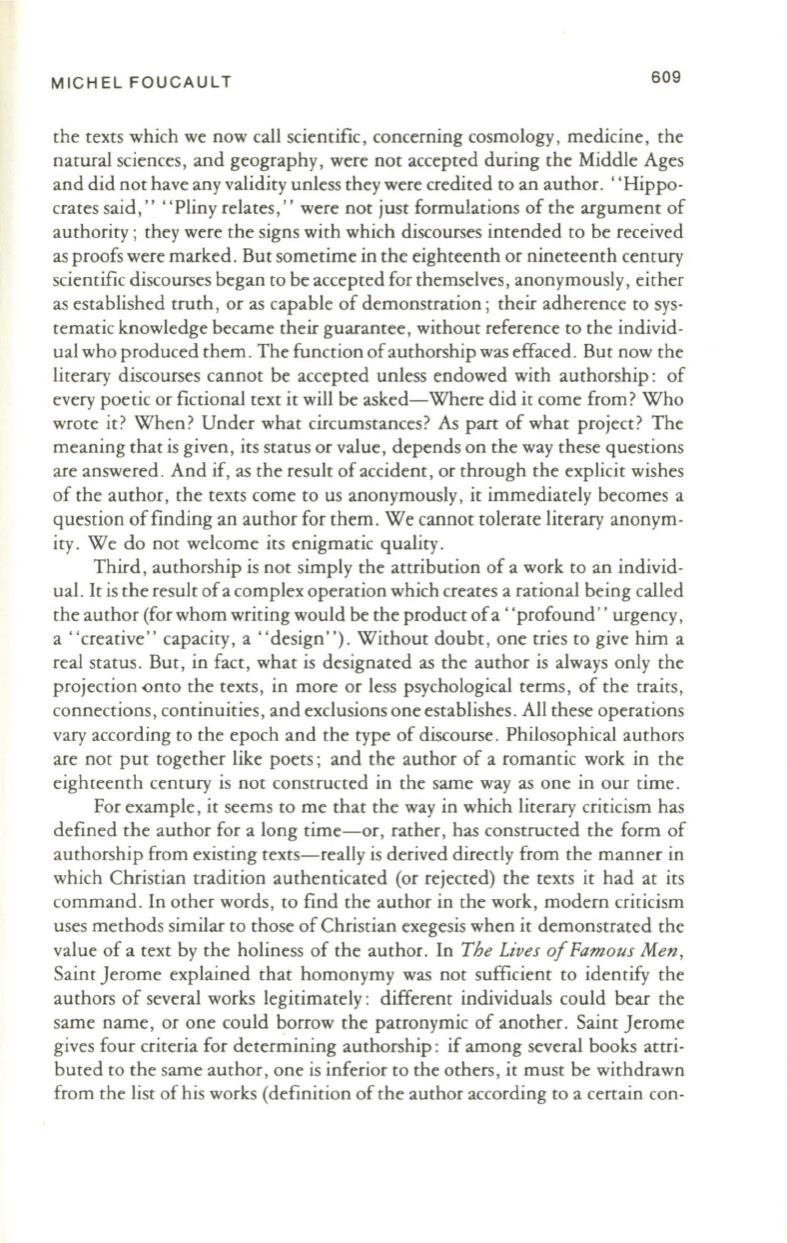
MICHEL FOUCAULT
609
the texts which we now call scientific , concerning cosmology , medicine , the
natural sciences , and geography, were not accepted during the Middle Ages
and did not have any validity unless they were credited to an author. " Hippo–
crates said ," " Pliny relates ," were not just formulations of the argument of
authority; they were the signs with which discourses intended to be received
as proofswere marked . But sometime in the eighteenth or nineteenth century
scientific discourses began to be accepted for themselves , anonymously, either
as established truth, or as capable of demonstration ; their adherence to sys–
tematic knowledge became their guarantee , without reference to the individ–
ual who produced them. The function ofauthorship was effaced. But now the
literary discourses cannot be accepted unless endowed with authorship: of
every poetic or fictional text it will be asked-Where did it come from? Who
wrote it? When? Under what circumstances? As part of what project? The
meaning that is given , its status or value, depends on the way these questions
are answered. And if, as the result of accident, or through the explicit wishes
of the author , the texts come to us anonymously , it immediately becomes a
question of finding an author for them . We cannot tolerate literary anonym–
ity . We do not welcome its enigmatic quality.
Third , authorship is not simply the attribution of a work to an individ–
ual. It is the result ofa complex operation which creates a rational being called
the author (for whom writing would be the product ofa' 'profound " urgency,
a " creative" capacity, a "design " ). Without doubt, one tries to give him a
real status . But, in fact, what is designated as the author is always only the
projection onto the texts , in more or less psychological terms , of the traits ,
connections, continuities, and exclusions one establishes. All these operations
vary according to the epoch and the type of discourse . Philosophical authors
are not put together like poets ; and the author of a romantic work in the
eighteenth century is not constructed in the same way as one in our time .
For example , it seems to me that the way in which literary criticism has
defined the author for a long time-or, rather , has constructed the form of
authorship from existing texts- really is derived directly from the manner in
which Christian tradition authenticated (or rejected) the texts it had at its
command. In other words , to find the author in the work, modern criticism
uses methods similar to those of Christian exegesis when it demonstrated the
value of a text by the holiness of the author. In
The Lives ofFamous Men,
Saint Jerome explained that homonymy was not sufficient to identify the
authors of several works legitimately : different individuals could bear the
same name , or one could borrow the patronymic of another. Saint Jerome
gives four criteria for determining authorship : if among several books attri–
buted to the same author , one is inferior to the others, it must be withdrawn
from the list of his works (definition of the author according to a certain con-


